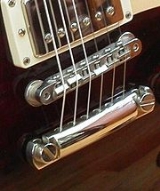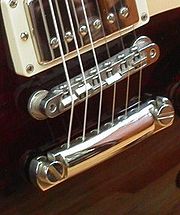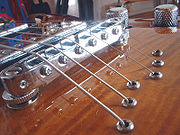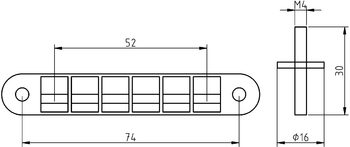
Tune-o-matic
Encyclopedia


Bridge (instrument)
A bridge is a device for supporting the strings on a stringed instrument and transmitting the vibration of those strings to some other structural component of the instrument in order to transfer the sound to the surrounding air.- Explanation :...
design for electric guitar
Electric guitar
An electric guitar is a guitar that uses the principle of direct electromagnetic induction to convert vibrations of its metal strings into electric audio signals. The signal generated by an electric guitar is too weak to drive a loudspeaker, so it is amplified before sending it to a loudspeaker...
s. It was designed by Ted McCarty
Ted McCarty
Ted McCarty was a pioneer of electric guitar design and production. This began when he was chosen as vice president of the of Gibson Guitar Corporation in 1949, then later as president in 1950. He remained president until 1966. This period became known as Gibson's golden age of electric guitars...
(Gibson Guitar Corporation
Gibson Guitar Corporation
The Gibson Guitar Corporation, formerly of Kalamazoo, Michigan and currently of Nashville, Tennessee, manufactures guitars and other instruments which sell under a variety of brand names...
president) and introduced in the Gibson Les Paul Custom
Gibson Les Paul Custom
The Gibson Les Paul Custom is a higher end variation of the Gibson Les Paul guitar. It was developed in 1954 after Gibson had introduced the Les Paul model in 1952.-Notable Les Paul Custom players:...
guitar in 1954. In 1955, it was used on the Gibson Les Paul
Gibson Les Paul
The Gibson Les Paul was the result of a design collaboration between Gibson Guitar Corporation and the late jazz guitarist and electronics inventor Les Paul. In 1950, with the introduction of the Fender Telecaster to the musical market, electric guitars became a public craze. In reaction, Gibson...
Gold Top. It was gradually accepted as a standard on almost all Gibson fixed-bridge guitars, replacing the previous wrap-around bridge design, except on the budget series.
Function
Guitar stringsStrings (music)
A string is the vibrating element that produces sound in string instruments, such as the guitar, harp, piano, and members of the violin family. Strings are lengths of a flexible material kept under tension so that they may vibrate freely, but controllably. Strings may be "plain"...
, especially steel strings, are not ideal vibrators. Generally the thicker the string, the shorter the effective length. This refers to the length of string involved in producing a sound, as opposed to the length between the nut and the bridge. Many guitar designs with fixed bridges have the bridge slanted or stepped so that the distance from nut to bridge is larger for thick strings. The Tune-o-matic extends this idea to make the distance adjustable for all the strings, within limits.
A common way of determining correct adjustment for a string is to compare the note at the 12th fret with the harmonic at the same position. The two should be as close as possible.
Construction

Vibrating string
A vibration in a string is a wave. Usually a vibrating string produces a sound whose frequency in most cases is constant. Therefore, since frequency characterizes the pitch, the sound produced is a constant note....
. Each saddle can be adjusted (moved back and forward) with a screw to control intonation
Intonation (music)
Intonation, in music, is a musician's realization of pitch accuracy, or the pitch accuracy of a musical instrument. Intonation may be flat, sharp, or both, successively or simultaneously.-Interval, melody, and harmony:...
. To prevent saddles from falling out of the bridge when no strings are installed, most models hold the saddles with a retainer wire or wires.
After the passing over the saddles each string goes to the tailpiece. Some guitars have a stopbar to hold strings, others have "strings through the body" construction which uses the body of the guitar to hold the end of the strings.
The Tune-o-matic bridge is not absolutely flat; and standard Gibson Tune-o-matic bridges have a 12" radius. Ideally, the radius should match the radius of fretboard for the most comfortable playing experience.
It is possible to fit the bridge either way round on the two body posts, which leads to a certain amount of confusion when changing strings, should the bridge fall off. Conventionally, the string length (intonation) adjustment screw heads of the older "Vintage" bridge face the neck, and the screw heads of the newer "Nashville" bridge face the stopbar. Unless the player wishes to completely reset the action and intonation, it is important to refit the bridge in the same orientation as before a string change, regardless of which way round it was to start with.
Varieties
Since its invention, different versions by Gibson and other companies have emerged. Gibson has introduced at least three versions that have minor differences in construction:- Standard Tune-o-matic is the first version that appeared in 1954. It used slim posts, but lacked slots for adjustment with screwdriver. The only way to adjust it was using a thumbwheel that was accessible only after loosening strings. Adjusting the bridge height required retuning of the whole guitar.
- Modern Tune-o-matic is the second version. It featured a much larger post with a threaded pot. It could be adjusted using a slotted screwdriver instead of a thumbwheel, but the posts were too large to be used in Fender guitars. It also required drilling to install.
- Refined standard Tune-o-matic is the third version of the Tune-o-matic. It featured both slim posts (as in "standard" version) and a screwdriver adjustment (as in "modern" one).
There are multiple widely known Tune-o-matic models that differ in the following parameters:

| Model | 1st-to-6th distance, mm | Between posts, mm | Post, diameter × length, mm | Thumbwheel diameter, mm | Saddles, mm | |||
|---|---|---|---|---|---|---|---|---|
| width | height | thickness | hole | |||||
| Gibson BR-010, ABR-1 ("Vintage") | 52 | 73.8 | M4×30 | 15 | 8.8 | 6.5 | 3.0 | M3 |
| Gotoh GE-103B, GEP-103B | 52 | 74 | M4×30 | 16 | 8.8 | 8.0 | 3.0 | M2.5 |
| Gotoh GE-103B-T, GEP-103B-T | 52 | 74 | M8×33.5 | 15 | 8.8 | 8.0 | 3.0 | M2.5 |
| Gibson BR-030 ("Nashville") | 51.6 | 74.3 | M5×25.1 | 16 | 8.8 | 10.8 | 2.55 | M3 |

